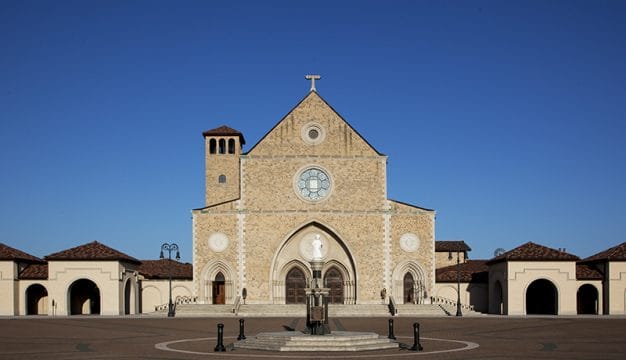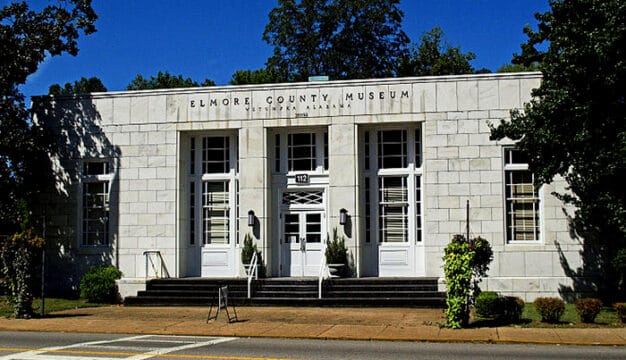Apalachees in Alabama
 Apalachee Tribal Flag
Though they called present-day Alabama home for only a few decades, the Apalachees were an important part of the state’s colonial-era history and an important ally of the French during their occupation of the Mobile Bay area. The Apalachees were a powerful and well-organized tribe that traced their ancestry back to the Mississippian peoples who occupied what is now northern Florida and southern Georgia during prehistoric times. They were forced from their traditional homeland in northwest Florida by European incursions and disease and warfare and resettled briefly among the people of the Creek Confederacy around Mobile, Mobile County, in the early eighteenth century.
Apalachee Tribal Flag
Though they called present-day Alabama home for only a few decades, the Apalachees were an important part of the state’s colonial-era history and an important ally of the French during their occupation of the Mobile Bay area. The Apalachees were a powerful and well-organized tribe that traced their ancestry back to the Mississippian peoples who occupied what is now northern Florida and southern Georgia during prehistoric times. They were forced from their traditional homeland in northwest Florida by European incursions and disease and warfare and resettled briefly among the people of the Creek Confederacy around Mobile, Mobile County, in the early eighteenth century.
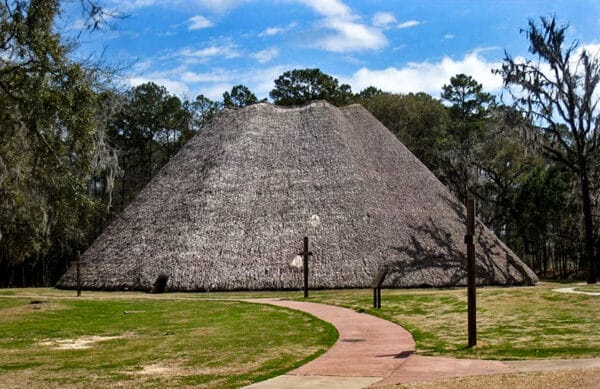 Apalachee Council House
The Apalachee originally lived in the Florida Panhandle in a territory that encompassed present-day Wakulla County. They spoke a Muskogean language related to the Creeks, Choctaws, and other southeastern peoples. Prior to European contact, the Apalachees lived in highly stratified societies with a complex system of government headed by chiefs, leading warriors, shamans, and counsellors. Like other southeastern Native American groups, the Apalachee were a matrilineal society that determined kinship in relationship to the mother’s family. They cultivated corn, beans, squash, and other vegetables and gathered numerous varieties of wild nuts and berries for food in addition to fishing and hunting indigenous animals, including bear, deer, and varieties of small game. The Apalachees developed a complex religious belief system, and the “ball game,” similar to the type of stickball played by other southeastern Indians, played an important role in town social and religious life.
Apalachee Council House
The Apalachee originally lived in the Florida Panhandle in a territory that encompassed present-day Wakulla County. They spoke a Muskogean language related to the Creeks, Choctaws, and other southeastern peoples. Prior to European contact, the Apalachees lived in highly stratified societies with a complex system of government headed by chiefs, leading warriors, shamans, and counsellors. Like other southeastern Native American groups, the Apalachee were a matrilineal society that determined kinship in relationship to the mother’s family. They cultivated corn, beans, squash, and other vegetables and gathered numerous varieties of wild nuts and berries for food in addition to fishing and hunting indigenous animals, including bear, deer, and varieties of small game. The Apalachees developed a complex religious belief system, and the “ball game,” similar to the type of stickball played by other southeastern Indians, played an important role in town social and religious life.
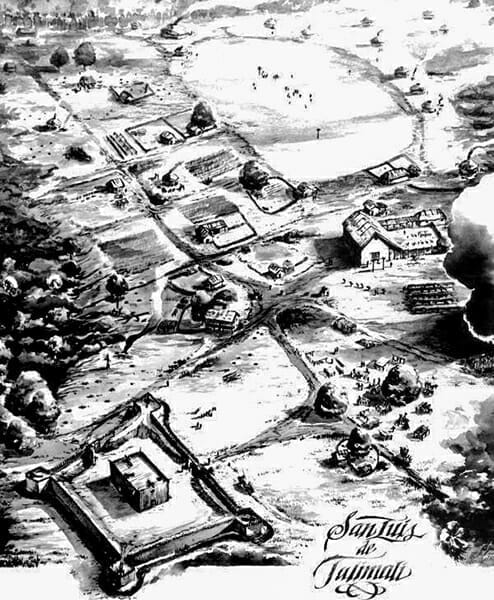 Mission San Luis
Early Spanish explorers in the Southeast, particularly Pánfilo de Narváez and Hernando de Soto, camped among them on their journeys into what is now Florida in the sixteenth century. In the 1600s, the Apalachees allowed Spanish priests to establish missions in towns such as Anhaica, Ocone, and Asile, thereby initiating an alliance that would last for nearly a century; many Apalachees converted to Catholicism as a result of their close relationship with the Spaniards. During Queen Anne’s War (1702-1713; the name given to the North American theater of the War of Spanish Succession), raids by the British and their Creek allies severely disrupted life in Apalachee communities and destroyed large portions of the Spanish mission network. In a devastating series of raids that became known as the “Apalachee Massacre,” forces led by Gov. James Moore of the British Province of Carolina destroyed several towns, killing hundreds and forcing more than 1,000 people into slavery among the British and their Creek allies. Survivors of these attacks fled northern Florida in 1704 and 1705 to French Mobile.
Mission San Luis
Early Spanish explorers in the Southeast, particularly Pánfilo de Narváez and Hernando de Soto, camped among them on their journeys into what is now Florida in the sixteenth century. In the 1600s, the Apalachees allowed Spanish priests to establish missions in towns such as Anhaica, Ocone, and Asile, thereby initiating an alliance that would last for nearly a century; many Apalachees converted to Catholicism as a result of their close relationship with the Spaniards. During Queen Anne’s War (1702-1713; the name given to the North American theater of the War of Spanish Succession), raids by the British and their Creek allies severely disrupted life in Apalachee communities and destroyed large portions of the Spanish mission network. In a devastating series of raids that became known as the “Apalachee Massacre,” forces led by Gov. James Moore of the British Province of Carolina destroyed several towns, killing hundreds and forcing more than 1,000 people into slavery among the British and their Creek allies. Survivors of these attacks fled northern Florida in 1704 and 1705 to French Mobile.
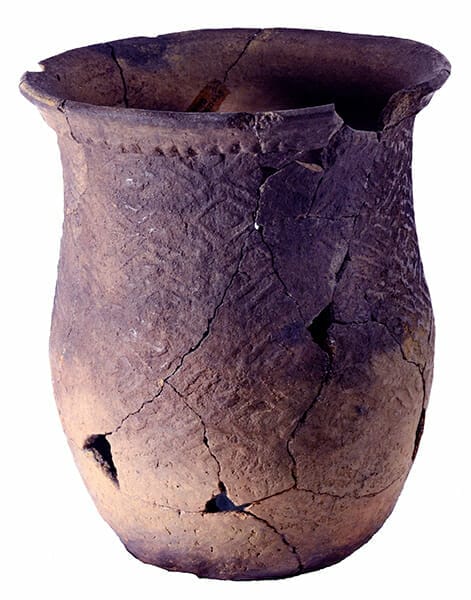 Apalachee Jar
French officials at their newly established colonial administrative center of Mobile encouraged the Apalachees from Mission San Luis (modern Tallahassee, Florida) to settle in the Mobile Bay area. Some established a village north of Mobile near present-day Mount Vernon, with others eventually moving across the Mobile-Tensaw Delta onto lands that are now part of Historic Blakeley State Park. The Apalachees became well integrated into life in colonial Mobile. Practicing Catholics, they had their own chapel and priest, participated in the celebrations for the feast day of St. Louis (an important French saint and former king of the nation), baptized their children, and recorded the sacrament in the local diocese registers. They played an important role in the economic life of the community, as well, trading their traditional pottery, copies of European-style earthenware, and a variety of foodstuffs to the French colonists in return for a variety of items, including tools, clothing, and jewelry. When many French colonists left this area following its cession to the British after defeat in the Seven Years War (1756-1763, known as the French and Indian War in North America), the Apalachees left as well. They established a new settlement along the Red River in central Louisiana, where a few hundred descendants remain today in Rapides Parish.
Apalachee Jar
French officials at their newly established colonial administrative center of Mobile encouraged the Apalachees from Mission San Luis (modern Tallahassee, Florida) to settle in the Mobile Bay area. Some established a village north of Mobile near present-day Mount Vernon, with others eventually moving across the Mobile-Tensaw Delta onto lands that are now part of Historic Blakeley State Park. The Apalachees became well integrated into life in colonial Mobile. Practicing Catholics, they had their own chapel and priest, participated in the celebrations for the feast day of St. Louis (an important French saint and former king of the nation), baptized their children, and recorded the sacrament in the local diocese registers. They played an important role in the economic life of the community, as well, trading their traditional pottery, copies of European-style earthenware, and a variety of foodstuffs to the French colonists in return for a variety of items, including tools, clothing, and jewelry. When many French colonists left this area following its cession to the British after defeat in the Seven Years War (1756-1763, known as the French and Indian War in North America), the Apalachees left as well. They established a new settlement along the Red River in central Louisiana, where a few hundred descendants remain today in Rapides Parish.
Although the Apalachees’ stay in Alabama was relatively brief, their legacy survives in the form of prominent place names. The Apalachee River, a stream in the Mobile-Tensaw Delta that empties into Mobile Bay, is named for them. Bayou Salome, which runs through Historic Blakeley State Park and empties into the Tensaw River, is named in honor of the wife of the chief of the Apalachees in the mid-1700s.
Additional Resources
Hamilton, Peter. Colonial Mobile. New York: Houghton Mifflin, 1898.
Hann, John H. The Native American World Beyond Apalachee: West Florida and the Chattahoochee Valley. Gainesville: University Press of Florida, 2006.
Higginbotham, Jay. Old Mobile: Fort Louis de la Louisiane, 1702-1711. Mobile: Museum of the City of Mobile, 1977.
McWilliams, Richebourg G., trans. and ed. Fleur de Lys and Calumet; Being the Pénicaut Narrative of French Adventure in Louisiana. Tuscaloosa: University of Alabama Press, 1988.


